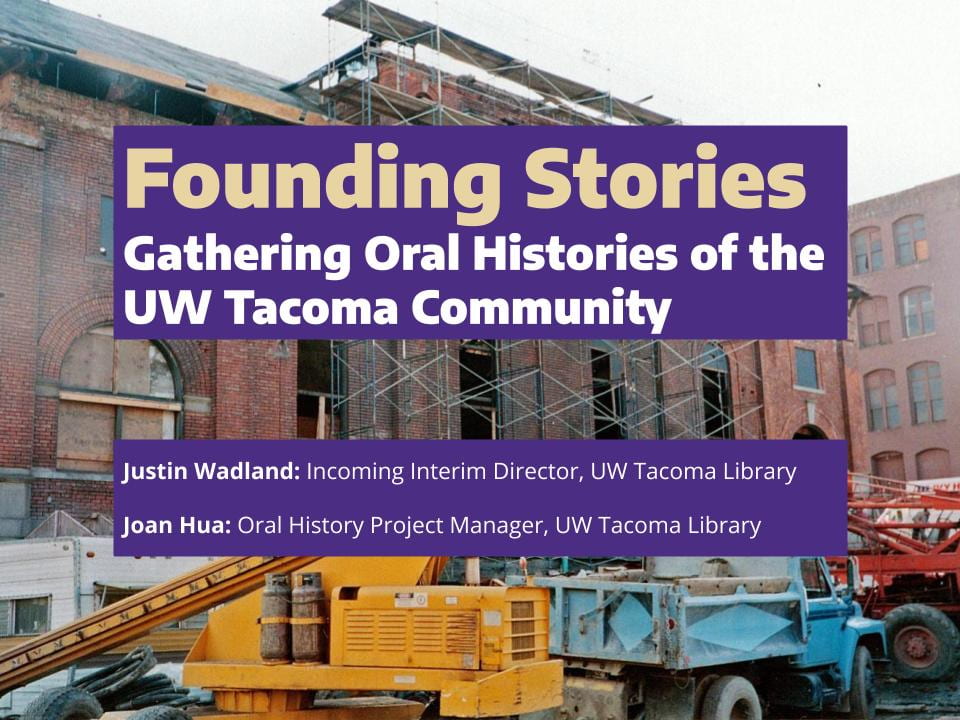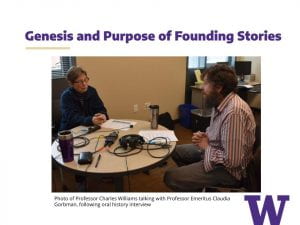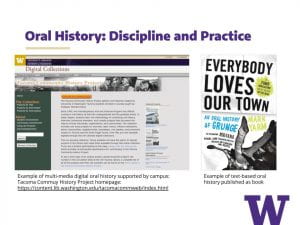Do you know your UW Tacoma campus history? Let’s find out!
-
UW Tacoma started in just one office building. What was the name of the building?
-
The concrete floor in some campus buildings has a common brown-colored stain. What was it meant to metaphorize?
* * *
Fun facts and lore can be entertaining, but there’s so much more to oral history. On November 18, Justin Wadland (incoming Interim Director of the UW Tacoma Library) and Joan Hua (Oral History project Manager, UW Tacoma Library)—that’s me—visited professor Kim Davenport’s IAS 305 seminar An Interdisciplinary Look at Our Campus History to talk about practicing oral history and a new digital oral history project about UW Tacoma’s campus history. Students as well as members of the campus community attended. If you missed it, here is a blog-style recap.

To get us thinking about the meaning of oral history, Justin shared two Chinese words he learned that juxtapose two different types of history: 正史 zhèng-shǐ (official history) and 野史 yě-shǐ (“wild history”). Chinese written history dates back over 3000 years. “Wild history,” on the other hand, refers to unofficial historical accounts. Oral history, Justin said, resembles yě-shǐ in that it tends to reflect personal experiences. I might add that oral history is not meant to be less true or a divergence from the facts. Rather, it enriches knowledge by offering multiplicity. You can see Oral History Association’s definition here.
The UW Tacoma Library launched the UW Tacoma Oral History: Founding Stories project this fall. You can preview some excerpts on the Library’s SoundCloud and follow on social media using #UWTFoundingStories. This yearlong project encompasses work around research, interviewing, recording, and collection care of the digital oral histories about the founding of UW Tacoma. The project’s genesis was a research project and essay on HistoryLink.org by Justin and professor Charles Williams. Building on our established understanding of oral history, we shared the goals of the Founding Stories project, which include gaining insights into how the individual lives intersect with the larger history of the institution of UW Tacoma. At the core, we might have a research question like, “How was UW Tacoma established?” But the inquiry is not simply about collecting a series of facts or laying out a chronology. We also know that the creation of UW Tacoma was the culmination of community efforts and groups working in parallel and in concert with one another. Many have contributed to the shaping of this community.

So far, we have had interviews with 10 of the founding faculty members. From these interviews, we’ve learned about the initial workshop in April 1990; we’ve learned that there was a truly experimental spirit in the development of the curriculum. We have interviewed community leaders and government officials, who orchestrated the passing of the legislation that led to the creation of five “branch campuses” in Washington state. We have also interviewed longtime staff members, who contributed their perspectives on the move to the permanent campus, the sense of community in the early days, and meaningful relationships forged with former students. Themes start to emerge as we build and contextualize the collection, and they range from higher education to historic preservation, urban revitalization, and more. In the seminar, we discussed excerpts of interviews and impressions of the early years of UW Tacoma students derived from these excerpts. Oral history is defined by its personal and intimate characteristics. From individual experiences and perspectives, we glean the transformative impact of education and how UW Tacoma touched people’s lives.
As practitioners of oral history, we try to get at these nuances and complexity in our interviews. But beyond the interviews, there are also many parts to an oral history project. I discussed our work behind the scenes, in which we create archival and preservation records for each oral history. Textual information such as full transcriptions, metadata, abstracts, biographies, and subject terms enable retrieval of the audio recordings. The Library stewards the collection by creating accessibility and discoverability, as well as safeguarding the recordings from degradation and deterioration. This work allows future researchers to utilize the recordings as primary source materials to produce scholarly analyses and educational work, as well as multimedia stories. (And maybe trivia quizzes? We’re getting to the answers!)

If we inquire into the past, we realize the “official history” written in books offer only one version of the narrative, often from the point of view of those with power. The diverse perspectives and firsthand, personal accounts expressed in oral histories offer a counterpoint to the single, authoritative narrative and place them in a human context.
* * *
So now, here are the answers, embedded in context.
-
Answer: Founding faculty and staff worked on the top floors of the historic Perkins Building on A St. at E 11th St. Classrooms and faculty offices were on the seventh and eighth floor, offices were on the sixth floor, and the library was on the fifth floor. Suzanne Klinger, one of the first two librarians, says in her interview that since the printing presses for the Tacoma Ledger used to be in that space, the floors were reinforced and could therefore take the weight of the bookshelves.
-
Answer: Historian Michael Sullivan shares in his interview that architect Charles Moore—who designed the Washington State History Museum—chose this brown stain for the concrete floor to not only acknowledge the industrial origins of the warehouse buildings but also to reference academic learning, thinking, and writing by creating a stain that resembles parchment.